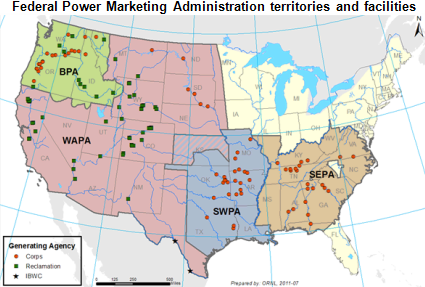
Federal Power Marketing Administrations operate across much of the United States

Notes: "Corps" is the Army Corps of Engineers; "Reclamation" is the U.S. Bureau of Reclamation; and "IBWC" is the International Boundary and Water Commission. The Power Market Administrations (PMAs) shown include the Bonneville Power Administration (BPA), the Western Area Power Administration (WAPA), the Southeastern Power Administration (SEPA), and the Southwestern Power Administration (SWPA). Click map to enlarge.
Four federal Power Marketing Administrations (PMAs) operate electric systems and sell the electrical output of federally owned and operated hydroelectric dams in 33 states. The Bonneville Power Administration (BPA), the Western Area Power Administration (WAPA), the Southeastern Power Administration (SEPA), and the Southwestern Power Administration (SWPA) marketed 42% of the nation's hydroelectricity in 2012, representing 7% of total generation in the United States.
Of the four PMAs, BPA and WAPA are much larger in terms of the volume of electricity marketed than SWPA and SEPA. Although some small geographic overlap occurs, the four PMAs generally have self-contained territories. These territories do not include the northeastern states and much of the Midwest.
A PMA's primary purpose is to market wholesale power, and it usually plays a role in transmission and electric power systems as well. With some exceptions, the PMAs generally do not own electric generating plants. For example, the Grand Coulee hydroelectric plant in Washington state is owned and operated by the U.S. Bureau of Reclamation. BPA markets the electricity generated by that plant and also acts as the balancing authority for the region, which means it ensures that electricity supply matches electricity demand at all times.
PMA power is largely hydroelectric except for the Columbia Nuclear Generating Station, which is owned by BPA. In 2012, the PMAs marketed 42% of the nation's hydroelectric generation. By federal statute, PMAs sell power primarily to preference customers, which largely consist of publicly-owned and cooperative-owned utilities, although small amounts of power are also sold to Indian tribes, federal entities, investor-owned utilities, and some industrial customers. For example, access to the relatively cheap Columbia River hydroelectric power gave rise to the Northwest's significant aluminum smelting industry.
The PMAs market electricity generated from some of the nation's largest river basins, including the Columbia and Colorado. Four of the nation's six largest hydroelectric dams are affiliated with the PMAs. Three of the nation's top five hydroelectric facilities are located on the Columbia River in BPA's operating territory. WAPA markets power from the Hoover Dam, which is the nation's sixth largest hydroelectric power facility and is located on the Colorado River.
PMAs also play a large role in transmission, both as transmission owners (with the exception of SEPA) and transmission operators. BPA alone operates and maintains three-quarters of the high voltage transmission system in its operating territory. All four of the PMAs function as balancing authorities for their regions.
Most of the power marketed by PMAs is relatively inexpensive because it relies mainly on hydroelectric dams that were built and paid for decades ago. By law, PMAs are required to set rates to cover costs "at the lowest possible rates to consumers consistent with sound business principles," forgoing any profits.
The PMAs also receive financial support from the U.S. government. This support, in some cases, includes allowing the PMAs to borrow money from the U.S. Treasury at lower interest rates than would be available through public bond issuances. In other cases, U.S. government financial support is less transparent, such as the implicit government backing of BPA's Energy Northwest bonds (see Chapter 4 in EIA's Direct Federal Financial Interventions and Subsidies in Energy in Fiscal Year 2010). The Federal Energy Regulatory Commission regulates PMA rates to ensure that they are set high enough to repay the U.S. Treasury on schedule.
Tags: electricity, generation, hydroelectric, transmission